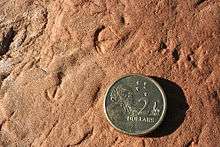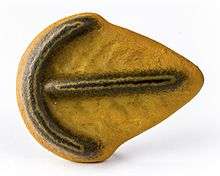Parvancorina
| Parvancorina | |
|---|---|
 | |
| Schematic reconstructions of P. sagitta and P. minchami | |
| Scientific classification | |
| Kingdom: | Animalia |
| Phylum: | incertae sedis: Arthropoda? Mollusca? |
| Genus: | Parvancorina Glaessner 1958 |
| Type species | |
| P. minchami Glaessner 1958 | |
| Species | |
| |
Parvancorina is a genus of shield-shaped bilaterally symmetrical fossil animal that lived in the late Ediacaran seafloor. It has some superficial similarities with the Cambrian trilobite-like arthropods.
Etymology
The generic name is derived from a crasis compound word from the Latin parva ancora (small anchor).
The specific name of the type species, P. minchami, honors Mr. H. Mincham, the private collector, who in 1957 had collected and presented a number of fine specimens of Ediacaran fossils to the South Australian Museum.
The specific name of P. sagitta is the Latin word sagitta (arrow), in direct reference to the arrow-like shape.
Occurrence
P. minchami fossils were first discovered in the Ediacara Member of the Rawnslay Quartzite, Flinders Ranges, in South Australia.[1] This species is also known from deposits of the Verkhovka, Zimnegory and Yorga Formations in the White Sea area of the Arkhangelsk Region, Russia. Additionally, similar poorly preserved Parvancorina sp. fossils were found in Lyamtsa Formation of this Russian region.[2]
P. sagitta is found in the Verkhovka formation on the Solza River, White Sea area of the Arkhangelsk Region, Russia.[3]

Description
It has a raised ridge down the central axis of symmetry. This ridge can be high in unflattened fossils. At the 'head' end of the ridge there are two quarter-circle-shaped raised arcs attached. In front of this are two nested semicircular lines. Teeth seem to come from the raised parts pointing into the centre spaces. These may show as raised lines.
The fossils are normally about 1 centimetre (0.39 inches) in each of width and length, but can be up to 2 centimetres (0.79 inches).
Affinity
In attempting to determine its phylogenic relationships, Parvancorina has been compared with trilobite-like arthropods, such as Skania fragilis from the Burgess Shale Biota, Canada, and Primicaris larvaformis from the Chengjiang Biota, China.[4][5] However, the growth form of Parvancorina is unusual for an arthropod,[2] and its apparent sessile mode of life appears to rebut an arthropod affinity.[6] Furthermore, the strong resemblance of P. sagitta to the primitive mollusk-like bilateran Temnoxa[3] and similarities to parts of Kimberella[7] casts further doubt on an arthropod affinity.
Lifestyle and habitus
The living Parvancorinas typically lived with their "heads" parallel to the current direction.[8] Overfolding of the fossils from all sides contradicts any form of stalked attachment to the sea floor.[9]
See also
References
- ↑ Glaessner, Martin F. (1958). "New Fossils from the Base of the Cambrian in South Australia" (PDF). Transactions of the Royal Society of South Australia. 81: 185–188. Archived from the original (PDF) on 2007-09-29.
- 1 2 Naimark, E. B; Ivantsov, A. Yu (2009). "Growth variability in the late Vendian problematics Parvancorina Glaessner". Paleontological Journal. 43 (1): 12–8. doi:10.1134/S003103010901002X.
- 1 2 Ivantsov, A.Y.; Malakhovskaya, Y.E.; Serezhnikova, E.A. (2004). "Some Problematic Fossils from the Vendian of the Southeastern White Sea Region" (PDF). Paleontological Journal. 38 (1): 1–9. Archived from the original (PDF) on 2007-07-04.
- ↑ Lin, Jih-Pai; Gon, Samuel M; Gehling, James G; Babcock, Loren E; Zhao, Yuan-Long; Zhang, Xing-Liang; Hu, Shi-Xue; Yuan, Jin-Liang; Yu, Mei-Yi; Peng, Jin (2006). "A Parvancorina-like arthropod from the Cambrian of South China". Historical Biology. 18 (1): 33–45. doi:10.1080/08912960500508689.
- ↑ Glaessner, M. F. (1980). "Parvancorina - an Arthropod from the Late Precambrian Fauna of the Ediacara Fossil Reserve" (PDF). Records of the South Australia Museum. 13: 83–90.
- ↑ Paterson, John (2010). International Palaeontology Congress. London.
- ↑ Grazhdankin, Dmitriy (2015). "Patterns of Evolution of the Ediacaran Soft-Bodied Biota". Journal of Paleontology. 88 (2): 269–83. doi:10.1666/13-072.
- ↑ Darroch, Simon A. F; Rahman, Imran A; Gibson, Brandt; Racicot, Rachel A; Laflamme, Marc (2017). "Inference of facultative mobility in the enigmatic Ediacaran organism Parvancorina". Biology Letters. 13 (5): 20170033. doi:10.1098/rsbl.2017.0033. PMC 5454237. PMID 28515329.
- ↑ Paterson, John R; Gehling, James G; Droser, Mary L; Bicknell, Russell D. C (2017). "Rheotaxis in the Ediacaran epibenthic organism Parvancorina from South Australia". Scientific Reports. 7: 45539. Bibcode:2017NatSR...745539P. doi:10.1038/srep45539. PMC 5371987. PMID 28358056.
External links
- Ediacaran.org
- Chris Nedin's Page
- Peripatus
- Trilobites.info
- Home of the Ediacaran
- Coutts, Felicity J; Bradshaw, Corey J.A; García-Bellido, Diego C; Gehling, James G (2017). "Evidence of sensory-driven behavior in the Ediacaran organism Parvancorina : Implications and autecological interpretations". Gondwana Research. Bibcode:2018GondR..55...21C. doi:10.1016/j.gr.2017.10.009.
